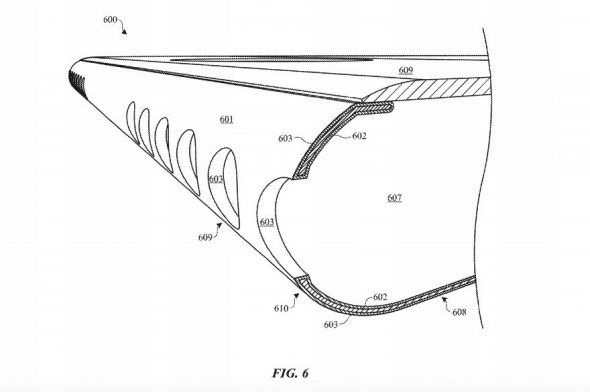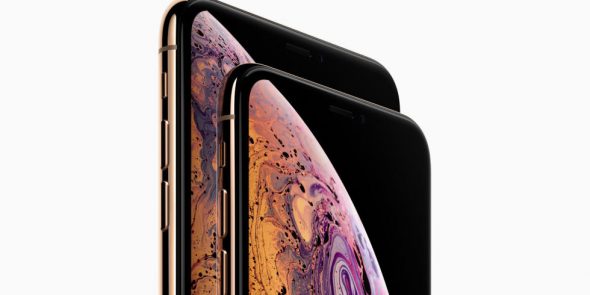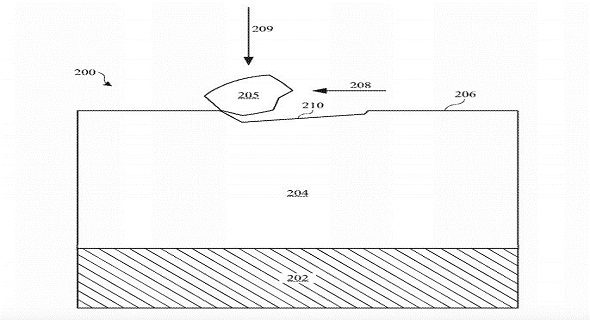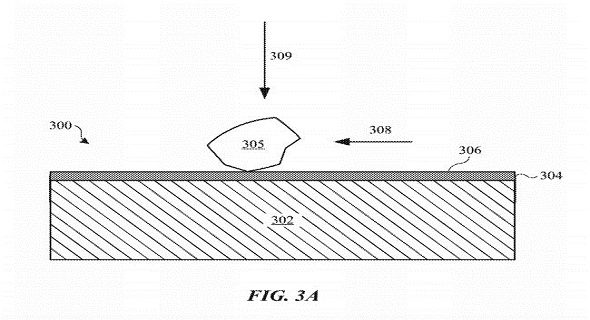We all remember what happened to the iPhone 6 Plus andProblem bendAnd Apple addressed that problem the following year when it introduced the iPhone 6s and addressed the bending problem by using a hardened metal, which is aluminum, the 7000 series. We also remember the problem of the Apple Watch made of stainless steel, or what is called stainless steel, as it suffered from scratches after three Only days of use. And we also remember, the problem of the iPhone 7, the version of the glossy black Jet Black, after experience it was found that it suffers from scratches quickly. The strange thing is that Apple stated that it is vulnerable to this, so it is recommended to use a protection case. The matter did not stop at the iPhone only, as it passed it to the MacBook and the aluminum scratches it suffered. It seems that Apple came out with the result of those experiences and problems and corrected all that in the near future, by filing a patent that makes the iPhone a device resistant to scratches and resistant to damage in general. What does that mean? What is the truth about that patent? Follow us.

Apple is working to make its products non-perishable. At the iPhone XS launch conference, Apple announced that it has an IP68 water-resistant rating, and this is one of the highest ratings available. Apple stated that the XS series is able to withstand water and other liquids such as tea, coffee, soda, and more. It also mentioned that it introduced a new type of glass in the manufacture of these phones.

And Apple stated that the front and back glass of the iPhone is the strongest glass ever made in a smartphone, and therefore it is resistant to scratches in an improved way than before. One of the advantages of that glass, especially the back, is that it works to smooth the wireless charging process. Not only that, Apple wants to make the iPhone resistant to scratches that, with their abundance, can destroy the phone.
Apple stated in its press release that we deal with devices such as phones, tablets, laptops, and smart watches, and those devices are usually accompanied by solid materials during normal use. These devices may drop or be subject to corrosion due to friction with these solids. And if the bodies of these devices are not sufficiently protected, they are subject to scratching, damage and cosmetic defects that are not hidden by everyone. And if those devices are exposed to oxidation, it may penetrate the outer metal body and reach the inner body of the devices. What we need is an enhanced outer layer of these metallic objects that prevents all of these problems.
And Apple's patent, like other patents, does not know when these technologies will be used, or whether or not they are actually used on new Apple devices. And usually it is not announced until it is tested on the ground. The documents for that patent were filed with the United States Patent and Trademark Office in March 2017.
And Apple stated that it used a strong oxide coating, whose hardness ranges between 300 and 500 HV, according to the Vickers hardness test, in previous iPhones such as the 6, 7 and others. The oxide coating can provide great resistance such as resistance and the potential for shocks that deform aluminum mainly, but it does not prevent them all. It is also prone to scratching in one form or another.

The previous figure shows the scratches that the iPhone 7 is exposed to if it is exposed to a solid material of metals, sand, stone, concrete, gravel, glass, or any other solid material during normal use. The number 205 represents the solid body, the number 210 represents the amount of scratching, and the number 200 represents the phone, and there are details in the article that cannot be mentioned.
Apple's patent indicates that Apple obtained a strong coating to prevent metal deformations from scratches and damage, especially if it was made of aluminum.

These coatings include an outer layer and an intermediate layer between the hard outer layer and the metal "body" layer. The porous oxide intermediate layer can have a lower hardness than the outer one but is stronger than the mineral. The outer layer is made of a ceramic material or a solid carbon material, such as diamond-like carbon. The intermediate layer acts as a structural support that resists impact and provides support to the solid outer layer.
This suggests that Apple can offer additional color options for its products, without worrying about scratches or wear and tear.
What do you think of Apple's patent? Will Apple succeed in achieving it? Let us know in the comments.
Source:


Huawei has become Apple's and Samsung's strongest competitors
Huawei competes with Samsung only because they depend on Android
Apple is tweeting alone with its iOS system.
Don't you notice Huawei imitating iPhone x 🤔?
So how do you compete with it?
In addition, Huawei competes only with its cheap prices
It does not offer anything new except imitating Samsung and Apple.
Nothing new is mentioned, all of them are subject to breakage and scratching, and for free to laugh at some.
Why should Apple use improved plastic for screens instead of breakable glass?
Let it be kept in the drawers, then a Chinese company comes to use it, with this policy Apple is five years behind the rest of the companies despite the flashiness and the features it offers in its phones, day after day Apple becomes a greedy and hated company from users
I am worried about Apple because any company whose profits rise dramatically and gives numbers like 99% satisfied with the iPhone or the like and the iPhone X which did not achieve sales and Apple continues with the tsunami of prices indicates that it is pumping high liquidity like an investment bank that pumps its money into real estate and sells and recovers and decides to continue in the market to revive the situation and then repeats the ball knowing that the number of properties it has is enough to maneuver and suddenly the bank discovers that the strong liquidity it has is true that it protects it but the other banks decide to meet on a unified price so it finds itself out of coverage and then it is stubborn and decides to pump money to investors and sells the properties to employees in installments to circulate the salary money and the Real Estate Authority records a recovery in its sales and then it reduces prices on the part of such as the iPhone XR for properties that were built years ago and were not sold so that people buy at the price of the rest of the banks and decides to offer new properties or those under construction to investors outside the country in exchange for a guarantee of their management and then the money circulates again and then Apple calculates the number of inventions that it has recovered the expenses of spending on and Then it rotates as it did from iPhone 6 to iPhone 8, it continued to sell the same product, but this type of money management has only one problem: time, because it is very difficult to understand what the next generation wants, as confirmed by a Mercedes official, that the companies’ time cycle today is 5 years, and the future cannot be known because they do not know what those born in 2020 want, and God knows best. Apple is 10 years old, and from now on it is heading towards decline until you see the financial reality. It is now Noah’s Ark, and if the wave goes away, there is no need for the Ark.
May God bless me with millions of what I said (then)
But it is true, I agree with you, my brother, Staff of Apple Capert, arrogant, exaggerated the prices, and exaggerated the scarcity and repetition without attractive advantages and changes, and this may expose it to a setback that may be strong and influential if you do not remedy its situation in the early years and thank you for your useful comment 🌹
It seems like you live on a planet all by yourself.
Everything you said is incorrect
And the correct one is exactly what I said
I began to suspect that you are being paid or paid by Samsung and Huawei
And mislead people
For your information, the iPhone X achieved the highest revenues for the company and contributed to its achievement.
Trillion dollars because his wish is high and his sales are strong
The iPhone will maintain its position and cannot be beaten
Because it is all the exclusive property of Apple with its system and most of its equipment
Unlike the free Android system, any company can put it on its phone for free
So why worry about foibile company
You should worry about Samsung, which is facing fierce competition
From Chinese companies, especially Huawei
Sir, the economist
I guess Apple if I read your comment
Will declare bankruptcy due to the severity of the verbal 😂😂😂
Oh my eyes on cleverness, intelligence and long-term vision
Allahu Akbar, you expect the only company that has exceeded its value in the market
A trillion dollars, or a third of the budget of the Arab countries, to collapse 🤪🤪🤪
It is only a patent that is not necessarily applied and if it is applied it will not see the light soon, but the greedy policy of Apple.
Why do you overreact to grumbling 🤔
Thank you
Only for research
$599 is the cost of repairing the iPhone XS MAX screen, which is the same price as the iPhone 7.
Apple has also raised the price of the XS screen compared to previous prices.
Compared to the low price of a Samsung Note screen switch
An article about Apple's new high cost and what Apple did not want to announce
The
I do not think that this standard will be adopted in the manufacture of the iPhone in the current period because it is simply inconsistent with Tim Cook's greedy policy, as he wants your phone to break and consumes as quickly as possible to change his screen or buy a new device and thus more profits, so the iPhone X was issued with a very weak hardness and portability High for fracture and above that, he lied and said that the device has high rigidity, hardness and badness Thank you for the useful article 🌹
Hatef ..
🤣🤣🤣
😄👍
Of course, a mighty innocence and Apple is able to achieve anything, but I do not expect that Apple will implement it soon, not because of its stinginess, but because of its greed for profits every year
If applied, the phone will maintain its beautiful appearance and a high price when sold ❤️🔥
Nice thing but I don’t expect to see it soon
Apple's policy between miserliness of benefits and potential profits.
Such technology means extra money on the iPhone price.
Yes ... we can see this layer of protection on special versions of it before it is launched on all releases.
This is something sweet once 😻
Indeed, the giant remains a giant and (Apple) a technological giant remains a giant of creative ideas and intellectual distinctions
* Exceptions
Beautiful, wonderful thing